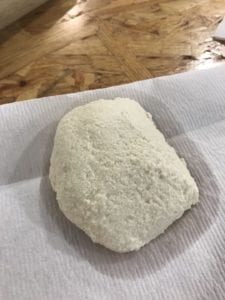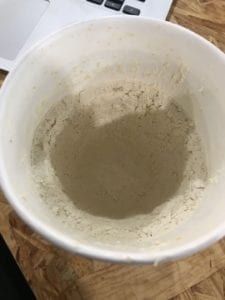This week I experimented with the milk and vinegar mixture to try and make a moldable bioplastic, following this article as a reference. I wanted to see the difference between using milk vs. soy milk, so I conducted two experiments:
Experiment 1: milk + kangle vinegar
There wasn’t enough white vinegar for both of the experiments and I could only find kangle vinegar on my FamilyMart run so I decided to try it out with the milk. I also adjusted the amount of vinegar to keep the same ratio as the recipe (depended on how much milk was in the small carton I had):
Ingredients:
- 200 ml milk
- 50 ml kangle vinegar
Before I even added the vinegar, the milk curdled/got plastic-y at the top as I was heating it:

I think I also messed up because I got distracted in the middle of experimenting and turned off the heat (before adding the vinegar), and came back to the mixture with it already curdled. I then turned the heat back on and added the vinegar, but the result was super crumbly and not what I expected at all.

I’m not sure if this was the result of me getting distracted in the middle, or the use of kangle vinegar rather than white vinegar.
When it dried, however, it was quite hard and reminded me of concrete:

Experiment 2: soy milk + white vinegar
There was enough white vinegar left to try it out with the soy milk.
Ingredients:
- 245 ml soy milk
- 59 ml white vinegar
This worked a lot better. It didn’t really curdle as much as the milk, but when strained, the result was much closer to the moldable dough I was expecting with the milk:

When it was dry, it was stronger than I had expected: it didn’t seem too brittle with the exception of the very edges – it stays in tact if you give it a little tug.

Experiment 2: soy milk + white vinegar on a larger scale
After these results, I decided to pursue the soy milk + white vinegar bioplastic and try to mold it to a food container using more soy milk.
Ingredients
- 1225 ml soy milk
- 295 ml white vinegar

It’s currently drying, so we’ll see how it turns out!
Leave a Reply